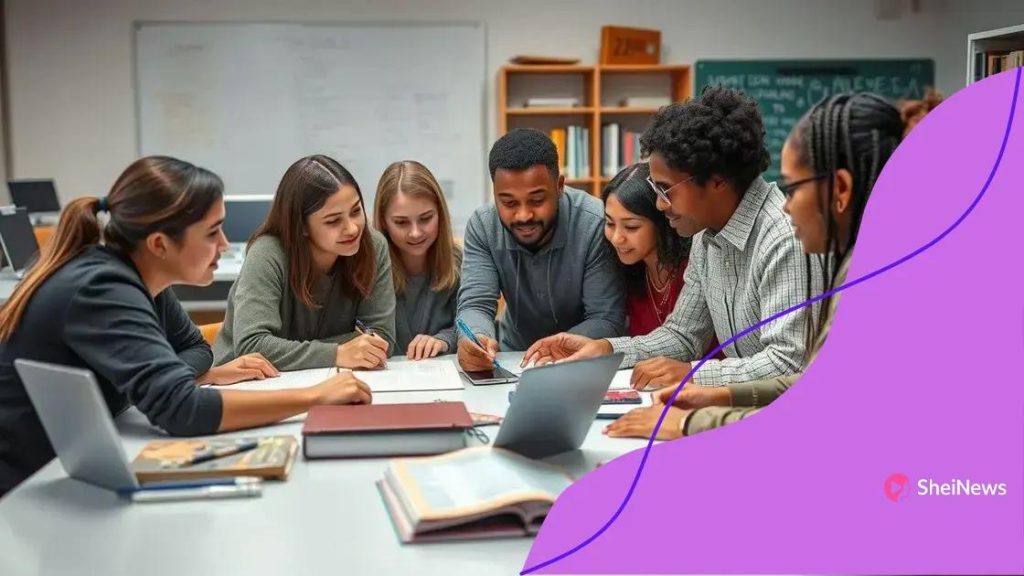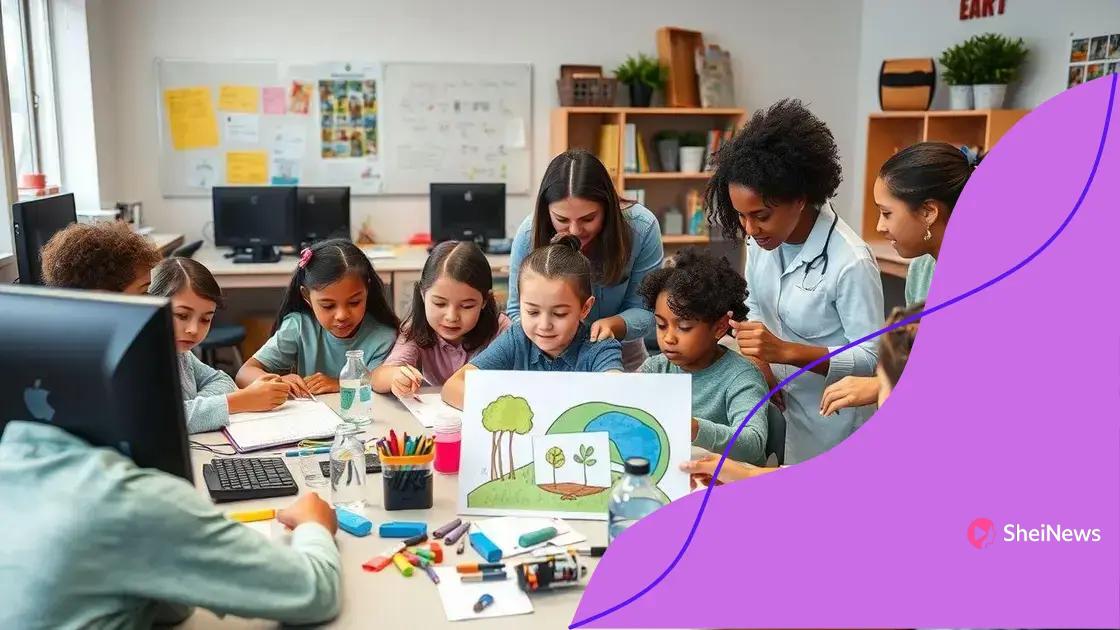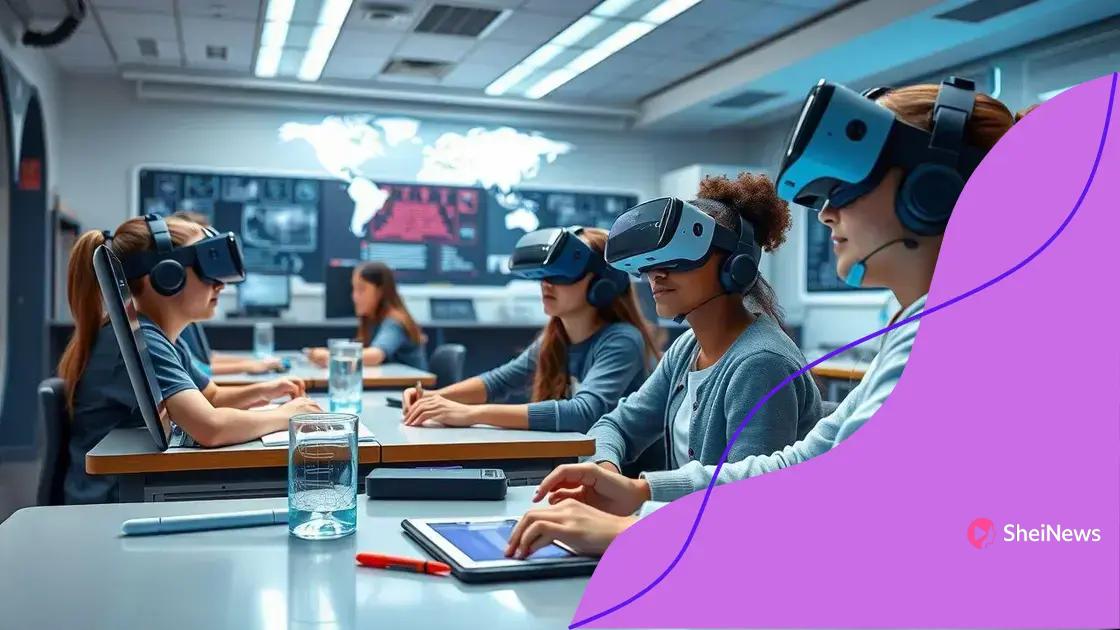Benefits of interdisciplinary learning for holistic development

Anúncios
Interdisciplinary education integrates diverse fields of study, enhancing students’ critical thinking, creativity, and problem-solving skills, while preparing them for real-world challenges through collaborative and experiential learning.
Benefits of interdisciplinary learning are increasingly recognized in modern education. By merging different fields, students can see connections that enrich their understanding, making learning more engaging and relevant. Ready to dive into how this approach opens up new horizons?
Anúncios
Understanding interdisciplinary learning
Understanding interdisciplinary learning is essential in today’s educational landscape. It combines knowledge from various disciplines, allowing students to see and understand concepts from multiple perspectives. This approach enhances problem-solving skills by encouraging learners to think outside the box.
What is interdisciplinary learning? It involves integrating different fields of study into a cohesive learning experience. For example, a project that combines science and art can help students grasp scientific concepts through creative expression.
The importance of interdisciplinary learning
Interdisciplinary education encourages students to make connections between subjects, fostering deeper understanding and retention. This method can lead to heightened engagement and interest in learning.
Anúncios
- Promotes critical thinking skills
- Encourages creativity and innovation
- Prepares students for real-world challenges
- Builds collaboration skills among peers
Moreover, students who engage in interdisciplinary learning often develop a more comprehensive view of the world. They learn to appreciate the interconnectedness of subjects, which can enhance their overall education.
Incorporating elements from different disciplines can also make learning more relatable and applicable to life outside the classroom. Students discover that what they learn in one field can apply to another, making their education more meaningful.
Examples of interdisciplinary learning in action
Examples abound in various educational settings. For instance, a unit on climate change can integrate science, geography, and literature. By examining scientific data, understanding geographic implications, and reading related novels, students gain a holistic view of the topic.
In this way, interdisciplinary learning creates a rich tapestry of knowledge that is both engaging and informative. This method not only prepares students for academic success but also equips them with skills necessary for their future careers.
Overall, embracing an interdisciplinary approach transforms education into an exciting journey of discovery and understanding.
Key advantages of interdisciplinary education
There are many key advantages of interdisciplinary education that significantly enhance the learning experience. This approach fosters a deeper understanding of subjects by encouraging students to draw connections across different fields.
One major advantage is that it promotes critical thinking skills. Students learn to analyze problems from multiple perspectives, which broadens their understanding and enhances creativity. By seeing how various disciplines intersect, learners can approach issues with innovative solutions.
Enhanced Engagement
Another advantage is enhanced student engagement. When learners observe real-world applications of their studies, they tend to be more invested and interested. This can lead to improved learning outcomes.
- Increased motivation to learn
- Greater retention of information
- Opportunities for collaborative projects
- Development of communication skills
This educational approach also prepares students for the complexities of the real world. In everyday life, many problems require knowledge from different fields, and interdisciplinary education equips students to tackle those challenges effectively.
Furthermore, interdisciplinary education fosters collaboration. Students often work together on projects that require input from various disciplines, enhancing teamwork skills that are valuable in the workplace.
Real-World Relevance
Finally, one of the strongest arguments for this educational model is its real-world relevance. Combining insights from science, humanities, and arts allows students to gain a more comprehensive view of societal issues.
This not only makes learning more relatable but also demonstrates how interlinked our world truly is. By emphasizing interdisciplinary education, schools prepare students for a future where adaptability and broad knowledge are essential.
How to implement interdisciplinary approaches

Implementing interdisciplinary approaches in education can be rewarding and transformative. It requires thoughtful planning and a willingness to embrace new teaching methods. Teachers can start by identifying themes or projects that connect different subjects.
For example, a project on sustainability could include science for understanding ecosystems, art for creating awareness campaigns, and math for analyzing data. This integration helps students see the relevance of what they learn.
Steps to implement interdisciplinary learning
Begin by collaborating with other educators. Teaming up can lead to innovative ideas and a richer educational experience for students.
- Identify common objectives across subjects
- Develop a shared curriculum that allows flexibility
- Create joint assessments to evaluate student understanding
- Engage students in discussions about the connections between disciplines
Incorporating interdisciplinary learning into lesson plans also involves creating opportunities for students to ask questions and explore issues in depth. This encourages curiosity and critical thinking.
Another effective strategy is to use project-based learning. Students can work on real-world problems, making connections between different fields of study as they seek solutions. This hands-on approach makes learning more effective and enjoyable.
Utilizing technology
Technology can also enhance interdisciplinary approaches. Utilizing online tools allows students to collaborate with peers worldwide or access diverse information, enriching their learning experience.
Moreover, teachers can incorporate multimedia resources such as videos and interactive websites. These resources can illustrate complex concepts and make the learning process more interactive.
By fostering an environment that supports interdisciplinary approaches, educators can cultivate a deeper understanding and appreciation for learning among students. It not only prepares them for academic success but also for real-world challenges they will face in the future.
Real-world examples of interdisciplinary success
Real-world examples of interdisciplinary success reveal how this approach can lead to innovative solutions and enhanced learning experiences. Many organizations and educational institutions have embraced interdisciplinary methods, producing remarkable outcomes.
One notable example is the collaboration between scientists and artists in environmental conservation. Artists create impactful visual representations of environmental issues, capturing attention and raising awareness. This partnership not only spreads knowledge about climate change but also inspires action.
Case Study: The Massachusetts Institute of Technology (MIT)
Another prominent example comes from the Massachusetts Institute of Technology (MIT), where various departments work together on technology projects. Students from engineering, computer science, and design frequently collaborate on projects like robotics or urban planning.
- Students learn to approach problems from multiple angles.
- Real-world projects enhance engagement and employability.
- Collaboration fosters innovation and creative problem-solving.
This interdisciplinary approach has led to innovations such as the development of unique robotic systems that address societal challenges.
Similarly, the educational program at Stanford University focuses on real-world problem-solving through interdisciplinary courses. Students from diverse fields come together to tackle pressing global issues, such as health care and sustainability. This model not only broadens their perspectives but also prepares them for the diverse challenges they may face in their careers.
Interdisciplinary Art and Science Initiatives
The intersection of art and science is another area where interdisciplinary efforts have thrived. Programs like “Art + Science” encourage collaborations between scientists and artists to communicate complex scientific concepts through creative outlets. These initiatives foster public understanding of science while also enriching artistic practice.
Through these real-world examples, it’s clear that interdisciplinary education offers numerous benefits, including enhanced creativity, critical thinking, and effective communication skills. By observing successful models in action, educators and students can appreciate the value of this dynamic approach.
Challenges in interdisciplinary learning
While there are many benefits to interdisciplinary learning, several challenges can arise when implementing this approach. Understanding these challenges is essential for educators and institutions seeking to adopt this model effectively.
One significant challenge is the need for collaboration among teachers from different disciplines. Many educators may be accustomed to teaching their subject in isolation. This can lead to difficulties in aligning curricula and objectives across fields.
Time Constraints
Another common challenge is time constraints. Teachers often face tight schedules that do not allow sufficient time to develop interdisciplinary projects. This can lead to a lack of depth in learning due to rushed lessons or assessments.
- Limited class time for project-based learning
- Scheduling conflicts between different subject areas
- Balancing standard curriculum requirements
- Pressure to cover material quickly for testing
Additionally, students may struggle with understanding the connections between disciplines without proper guidance. Educators must provide clear frameworks and support to help students apply knowledge from one subject to another effectively.
Resistance to change is also a significant barrier. Some educators may prefer traditional methods of teaching and may be hesitant to embrace new approaches. This reluctance can hinder collaboration and the overall effectiveness of interdisciplinary programs.
Resource Allocation
Resource allocation can pose another challenge in interdisciplinary education. Schools may lack the necessary tools or materials to support integrated learning. Ensuring that all disciplines have access to similar resources is essential for equity and effectiveness in learning.
Despite these challenges, many institutions successfully implement interdisciplinary programs by fostering a culture of collaboration and open communication. By addressing these hurdles, schools can create an enriching educational environment that benefits both students and educators.
Future trends in interdisciplinary education

Future trends in interdisciplinary education are shaping how students learn and engage with various subjects. As the world becomes increasingly complex, education systems are evolving to better prepare students for future challenges.
One emerging trend is the integration of technology into interdisciplinary learning. Virtual reality (VR) and augmented reality (AR) are being used to create immersive experiences that combine different fields of study. For example, students can explore historical sites in a social studies lesson while understanding the scientific principles behind their preservation.
Project-Based Learning
Project-based learning (PBL) is gaining popularity as a method that naturally lends itself to interdisciplinary approaches. This hands-on style encourages students to work on real-world problems, often requiring knowledge from various disciplines. By collaborating on these projects, students develop valuable skills such as teamwork and critical thinking.
- Encourages creativity through open-ended tasks
- Promotes authentic learning experiences
- Utilizes community resources and expertise
- Incorporates student interests and passions
Furthermore, there is a shift toward competency-based education, where students are assessed on their mastery of skills rather than just content knowledge. This trend aligns with interdisciplinary education by allowing students to demonstrate their understanding across multiple subjects.
Another important development is the focus on social-emotional learning (SEL) within interdisciplinary programs. Educators recognize the importance of emotional intelligence and self-regulation for student success. Integrating SEL into the curriculum helps students build strong relationships and enhances their collaboration skills.
Global Collaboration
Global collaboration is another key trend. Students can now connect with peers from around the world to tackle issues that transcend borders, such as climate change and public health. This global perspective fosters a deeper understanding of cultural differences and encourages students to think critically about their role in a global context.
The future of interdisciplinary education is bright, with innovative approaches that cater to the diverse needs of students. By embracing technology, project-based learning, and collaborative efforts, educators can create engaging and meaningful learning experiences that prepare students for a complex world.
FAQ – Frequently Asked Questions about Interdisciplinary Education
What is interdisciplinary education?
Interdisciplinary education blends different fields of study, allowing students to make connections and apply knowledge across subjects.
How can interdisciplinary approaches benefit students?
They enhance critical thinking, creativity, and problem-solving skills, making learning more engaging and relevant.
What are some examples of interdisciplinary projects?
Examples include combining science and art to address environmental issues or using math and history to analyze data about historical events.
What challenges might educators face when implementing interdisciplinary learning?
Challenges include collaboration among teachers, time constraints, resistance to change, and ensuring resource availability.





